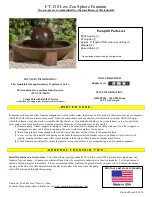
9
206546-02
SPECIFICATIONS
Range ................................................................Up to 30 ft. (9.1 m) [varies with surrounding temperature]
Sensing Angle....................................................Up to 150°
Electrical Load ..................................................Up to 100 Watt Maximum Incandescent
Bulb Type ..........................................................Medium Base, Type “A”, 100 Watt Maximum
Sensor Capacity .................................................Up to 360 Watt (3.0 A) Maximum Tungsten
Power Requirements ..........................................120 VAC, 60 Hz
Operating Modes ..............................................TEST, AUTO, and MANUAL MODE
ON-Timer .........................................................1, 5, 10 minutes
DualBrite® Timer ..........................................Off, 3, 6 hours, dusk-to dawn
Test Timer .........................................................5 Seconds
Manual Mode Timer .........................................Dusk-to-Dawn
SYMPTOM
POSSIBLE CAUSE
SOLUTION
Lights will not
come on.
1. Light switch is turned off.
2. Light bulb is loose or burned out.
3. Fuse is blown or circuit breaker is turned off.
4. Daylight turn-off is in effect.
5. Sensor not detecting movement.
6. Incorrect circuit wiring, if this is a new installation.
1. Turn light switch on.
2. Check bulb and replace if burned out.
3. Replace fuse or turn circuit breaker on.
4. Recheck after dark.
5. Re-aim the sensor to cover desired area. Adjust sensitivity
control.
6. Verify wiring is correct.
Lights come on in
daylight.
1. Light control may be installed in a relatively dark location.
2. Light control is in TEST.
1. The fixture is operating normally under these conditions.
2. Set control switch to 1, 5, or 10 minutes.
Lights come on for
no apparent reason.
1. Light control may be sensing small animals or automobile
traffic.
2. Sensitivity is set too high.
1. Re-aim sensor. Reduce sensitivity.
2. Reduce sensitivity.
Lights stay on
continuously.
1. The sensor may be picking up a heat source like an air vent,
dryer vent, or brightly painted, heat-reflective surface.
2. Light control is in Manual Mode.
3. Light control is in DualBrite® mode.
4. Sensitivity is set too high.
1. Re-aim sensor. Reduce sensitivity.
2. Switch to Auto.
3. Slide
DualBrite® switch to OFF position.
4. Reduce sensitivity.
Lights flash on
and off.
1. Light control is in the TEST mode and warming up.
2. Heat being reflected from other objects may be affecting the
sensor.
1. Flashing is normal under these conditions.
2. Re-aim sensor. Reduce sensitivity.
Seasonal Temperature Changes – The closer the surrounding temperature is to a person’s body heat, the less sensitive the sensor will appear. The greater
the temperature difference, the more sensitive the sensor will appear. The SENS control might need to be readjusted toward MIN or MAX as the outside
temperature changes for the different seasons. This is a normal part of the light sensor’s operation.
TROUBLESHOOTING GUIDE
CARE AND MAINTENANCE
• To prolong the original appearance, clean with clear water and a soft damp cloth only.
• Do not use paints, solvents, or other chemicals on this light fixture. They could cause a premature deterioration of the
finish. This is not a defect in the finish and will not be covered by the warranty.
• Do not spray with hose or power washer.
Содержание 530882
Страница 31: ...31 206546 02 ...










































